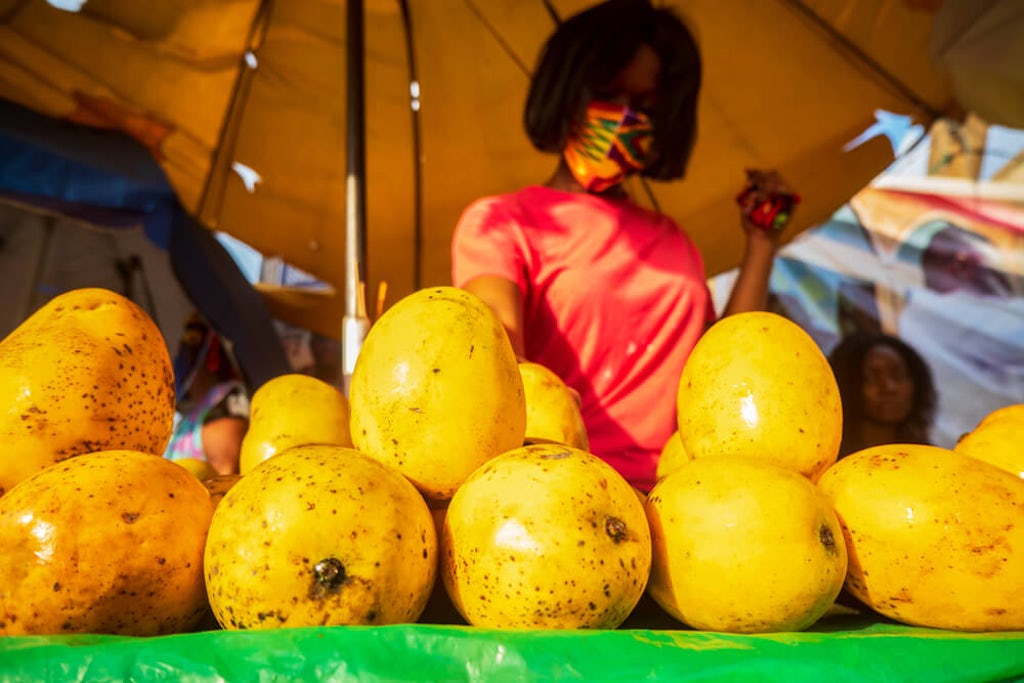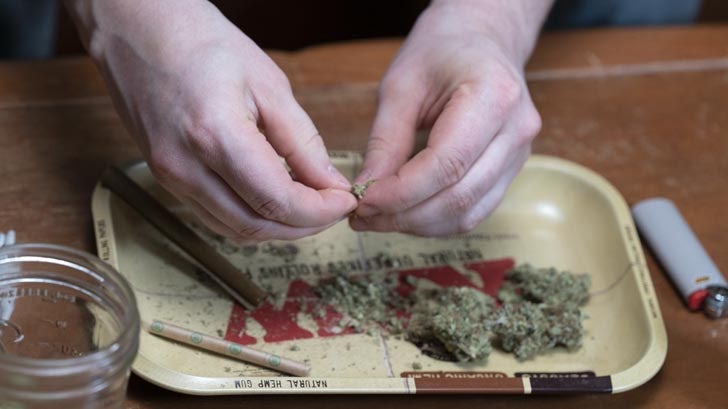Everyone has a favorite album they like to pair with cannabis, a movie they really love to watch when high, or that special secluded spot in town where the view, the breeze, and the simple tranquility of it all can make it the perfect place to smoke a joint. But along with music and movies, there are also specific foods that can affect your high, and we don’t just mean in terms of the munchies.
Certain foods naturally contain chemicals that may be able to affect your high — either by amplifying or tempering it — and can also interact with your body’s endocannabinoid system.
“It’s a really nuanced and complicated system and the foods we eat definitely influence it,” explained Dr. Codi Peterson, a clinical pharmacist, cannabis expert, and scientific advisor to The Cannigma. “But it’s not as simple a matter as ‘this food will get you more high.’”
The body produces endocannabinoids from the fats we eat, Dr. Peterson explained, and recommends keeping a plant rich, well-balanced diet in order to support a healthy gut microbiome and robust endocannabinoid system.
What is the endocannabinoid system?
First discovered by scientists in the early 1990s, the endocannabinoid system modulates a vast array of functions in the body including sleep, hunger, memory, pain, and inflammation. The ECS itself is composed of receptors (including CB1 and CB2) that are themselves activated or blocked by the cannabinoids produced within the human body (called “endocannabinoids”).
These receptors can also be influenced by the cannabinoids produced by cannabis, known as “phytocannabinoids.” How these plant-made cannabinoids interact with the ECS is at the core of all the ways that cannabis affect the human body.
Here are five of the most commonly mentioned foods that can affect your high.
1. Chocolate

Scientists have discovered two cannabinoids produced by the human body, anandamide (AEA) and 2-arachidonoylethanolamine (2-AG). Anandamide is often referred to as “the bliss molecule” because of its ability to help the body cope with stress and reduce anxiety1.
A 2003 study found that the so-called “runners high” is a result of the ECS producing higher levels of anandamide in response to the exercise2. A 2015 study performed on mice also found that running boosts blood levels of anandamide3.
What does this have to do with chocolate? Researchers have posited that substances in chocolate and cocoa powder “may mimic [cannabinoids] by activating receptors or increasing anandamide levels.”4 The researchers concluded that a practical implication of this “is that the amount of marijuana needed for medicinal purposes may be decreased by using it with chocolate.”
That may be a bit of a stretch, but increasing anandamide levels could enhance the blissful feeling of marijuana. Chocolate has been known to produce bliss regardless of cannabis consumption, so you may just be ingesting two things that feel good.
2. Beer and other alcohols

There are a number of views on mixing THC and alcohol, mainly that it will significantly augment the effects of both. This is actually borne out by the research as well. One clinical trial published in 2015 found “significantly higher blood THC” values among test subjects who consumed alcohol with cannabis, which they said could “possibly explain increased performance impairment observed from cannabis-alcohol combinations.”5
But alcohol can also change how the receptors of the ECS operate, at least in cases of alcohol abuse.
One review published in 2012 cited research that found that “CB1 contributes the motivational and reinforcing properties of ethanol, and chronic consumption of ethanol alters [endocannabinoid] transmitter levels and CB1 expression in brain nuclei associated with addiction pathways.”6
They added that “[endocannabinoid] release in response to ethanol mediates the reinforcing properties of this drug and that chronic ethanol use resulting in tolerance and dependence dramatically alters the function of [endocannabinoid] signaling.”
In other words, ethanol leads to a release of anandamide — which feels good — in the reward pathway in the brain. This feeling can be habit-forming and is connected to the urge addicts feel to keep using. Because alcohol abuse can deregulate the endocannabinoid system, people with an alcohol dependency can naturally have a stronger tolerance to cannabinoids.
3. Herbs like basil and oregano

Using fresh herbs in your cooking is not only a way to add flavor and vibrancy to your meals, it could also potentially boost the effects of cannabis. Two very commonly-used herbs, basil and oregano, include a variety of well-known phytocannabinoids also found in cannabis, including a-pinene, limonene, camphor, citronella, carvacrol, and beta-caryophyllene7.
These terpenes can have a variety of effects. Alpha-pinene, for example, which gives cannabis it’s woody aroma, may have an anti-anxiety effect. Limonene, which may help alleviate pain, gives many cannabis strains their inviting citrusy aroma.
The aromas and effects of these terpenes, which are common in herbs like basil and oregano, could enhance the effect of those same terpenes in cannabis preparations when taken together.
4. Omega 3 fats in fish

Most people’s diets today are heavy in omega-6 fats, the polyunsaturated fatty acids which are abundant in corn and grain. Our diets tend to be less abundant in omega-3 fatty acids, which are provided by fish, nuts and berries, and green vegetables. Both of these types of fatty acids interact with the endocannabinoid system, and anandamide itself is derived from arachidonic acid, an Omega-6 fatty acid8.
Furthermore, both human and animal research has found that omega-3 fats can modulate endocannabinoid tone, and are associated with lower risk of heart disease and diabetes. It is believed that the health of the endocannabinoid system is closely related to both of these disease states.9
What does this mean? Since both fatty acids can have very different effects on the ECS, it’s important that people consume a balanced diet of both omega-3 and omega-6 fatty acids. In America, people are much more likely to eat a diet that is higher in omega-6 fats, so balancing this by eating a diet that is richer in omega-3 fats can help ensure that your ECS is functioning in a more healthy manner.
5. Chew on some peppercorn to sober up?

In a 2014 interview with Howard Stern, Canadian rock legend and model train enthusiast Neil Young unveiled a trick he has for tempering the effects of cannabis when it’s hitting like a hurricane.
“Try black pepper balls if you get paranoid. Just chew two or three pieces.”
That might make you raise an eyebrow, but the there is some logic to this approach. . Peppercorns are high in the terpene beta-caryophyllene, which can have a relaxing, sedating effect. It likely helps with the overwhelming high by engaging with specific receptors in the ECS — the CB2 receptors. These receptors are not the receptors that cause the THC-high, but they still interact with THC and the actions of black pepper at these receptors could be the reason Neil Young endorses this method.
Does this mean that chewing a few peppercorns can instantly make you emerge from an intense THC high? No, but it is one example of how the terpenes in specific foods can potentially produce a noticeable physiological effect and could alter your cannabis experience.
FAAH and breaking down anandamide
The fatty acid amide hydrolase (FAAH) enzyme is responsible for breaking down anandamide in the body, and can reduce the body’s levels of the bliss molecule. The flavonoid kaempferol can inhibit the production of FAAH, so consuming foods that contain the flavonoid, such as blackberries, apples, or tomatoes, could potentially boost your anandamide levels — and the positive feelings it brings10.
Eating healthy is key
When considering which foods can affect your high and improve your cannabis experience, it’s not so much a matter of consuming a specific food in set quantities. It’s more a matter of adopting a healthy diet that will improve the functioning of your ECS. This means eating a balanced amount of omega-3 and omega-6 fats, as well as an ample amount of fresh fruits and vegetables, herbs and spices, fish, and healthy fats. In addition, a plant-based diet boosts the health and diversity of your gut bacteria, which are essential for the production of endocannabinoids.
The mango myth

If you’ve read anything on how foods can affect your high, then you’ve probably heard about the reputed benefits of eating mango when smoking marijuana. You may want to take these reports with a grain of salt, according to Dr. Peterson.
“The number one misnomer on the internet is that if you eat a mango you get more high because mangoes contain myrcene,” he said, adding that mangoes are not actually very high in myrcene11. Even if mangoes were high in myrcene, most fruits don’t produce essential oils in its fruit but rather in their skin, which in the case of mangoes contains urushiol, the same compound present in poison ivy and poison oak. So don’t start eating mango skins to get extra high or you’re likely to bite off more than you bargained for.
Sources
- Bluett, R. J., Gamble-George, J. C., Hermanson, D. J., Hartley, N. D., Marnett, L. J., & Patel, S. (2014). Central anandamide deficiency predicts stress-induced anxiety: behavioral reversal through endocannabinoid augmentation. Translational psychiatry, 4(7), e408. https://doi.org/10.1038/tp.2014.53
- Sparling, P. B., Giuffrida, A., Piomelli, D., Rosskopf, L., & Dietrich, A. (2003). Exercise activates the endocannabinoid system. Neuroreport, 14(17), 2209–2211. https://doi.org/10.1097/00001756-200312020-00015
- Fuss, J., Steinle, J., Bindila, L., Auer, M. K., Kirchherr, H., Lutz, B., & Gass, P. (2015). A runner’s high depends on cannabinoid receptors in mice. Proceedings of the National Academy of Sciences of the United States of America, 112(42), 13105–13108. https://doi.org/10.1073/pnas.1514996112
- James J. S. (1996). Marijuana and chocolate. AIDS treatment news, (No 257), 3–4.
- Hartman, R. L., Brown, T. L., Milavetz, G., Spurgin, A., Gorelick, D. A., Gaffney, G., & Huestis, M. A. (2015). Controlled Cannabis Vaporizer Administration: Blood and Plasma Cannabinoids with and without Alcohol. Clinical chemistry, 61(6), 850–869. https://doi.org/10.1373/clinchem.2015.238287
- Pava, M. J., & Woodward, J. J. (2012). A review of the interactions between alcohol and the endocannabinoid system: implications for alcohol dependence and future directions for research. Alcohol (Fayetteville, N.Y.), 46(3), 185–204. https://doi.org/10.1016/j.alcohol.2012.01.002
- Yang, Y., Kayan, B., Bozer, N., Pate, B., Baker, C., & Gizir, A. M. (2007). Terpene degradation and extraction from basil and oregano leaves using subcritical water. Journal of chromatography. A, 1152(1-2), 262–267. https://doi.org/10.1016/j.chroma.2006.11.037
- Sugiura, T., Kobayashi, Y., Oka, S., & Waku, K. (2002). Biosynthesis and degradation of anandamide and 2-arachidonoylglycerol and their possible physiological significance. Prostaglandins, leukotrienes, and essential fatty acids, 66(2-3), 173–192. https://doi.org/10.1054/plef.2001.0356
- Saleh-Ghadimi, S., Kheirouri, S., Maleki, V., Jafari-Vayghan, H., & Alizadeh, M. (2020). Endocannabinoid system and cardiometabolic risk factors: A comprehensive systematic review insight into the mechanistic effects of omega-3 fatty acids. Life sciences, 250, 117556. https://doi.org/10.1016/j.lfs.2020.117556
- Thors, L., Belghiti, M., & Fowler, C. J. (2008). Inhibition of fatty acid amide hydrolase by kaempferol and related naturally occurring flavonoids. British journal of pharmacology, 155(2), 244–252. https://doi.org/10.1038/bjp.2008.237
- Liu, H., An, K., Su, S., Yu, Y., Wu, J., Xiao, G., & Xu, Y. (2020). Aromatic Characterization of Mangoes (Mangifera indica L.) Using Solid Phase Extraction Coupled with Gas Chromatography-Mass Spectrometry and Olfactometry and Sensory Analyses. Foods (Basel, Switzerland), 9(1), 75. https://doi.org/10.3390/foods9010075
Sign up for bi-weekly updates, packed full of cannabis education, recipes, and tips. Your inbox will love it.

 Shop
Shop Support
Support
















